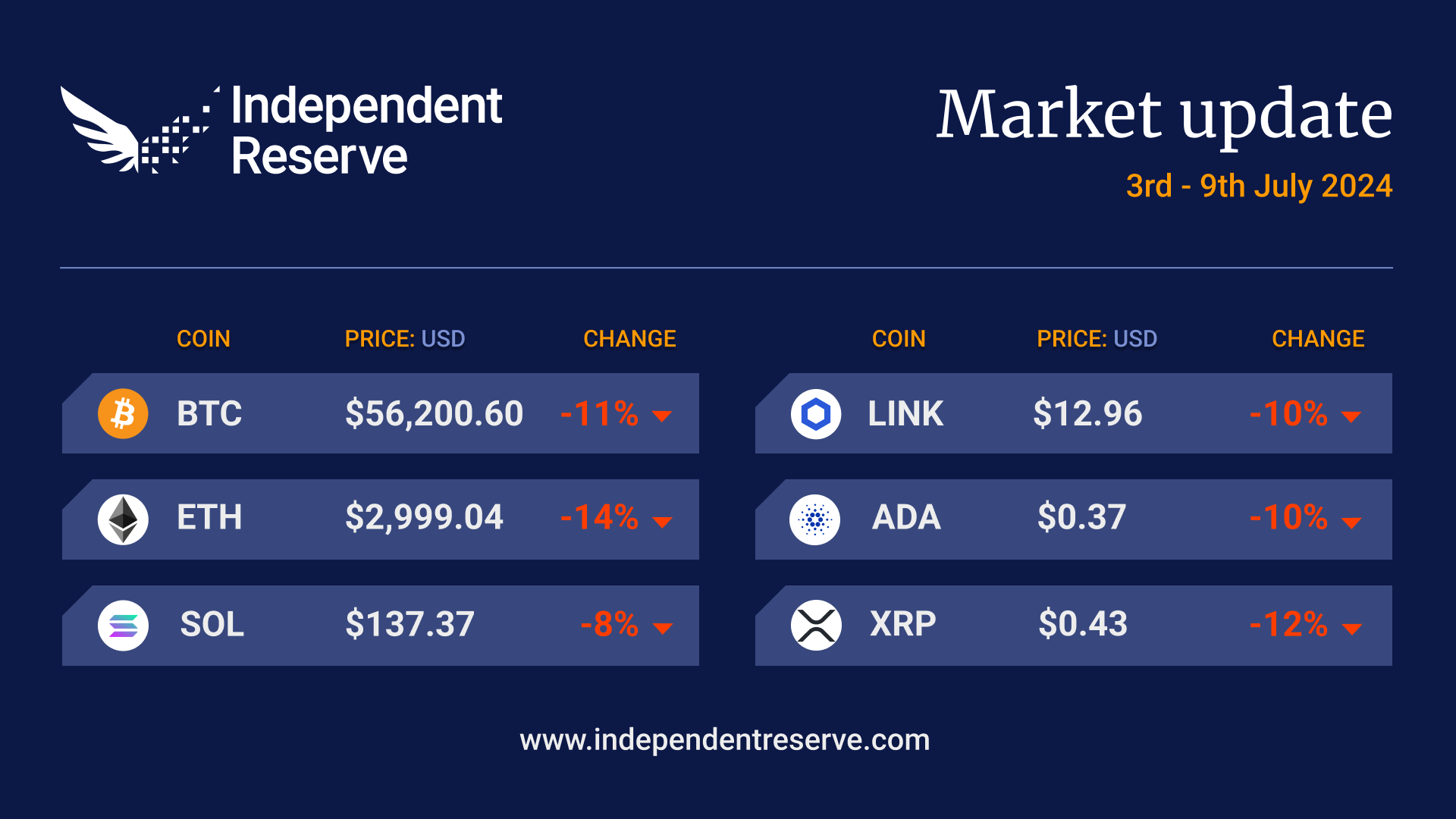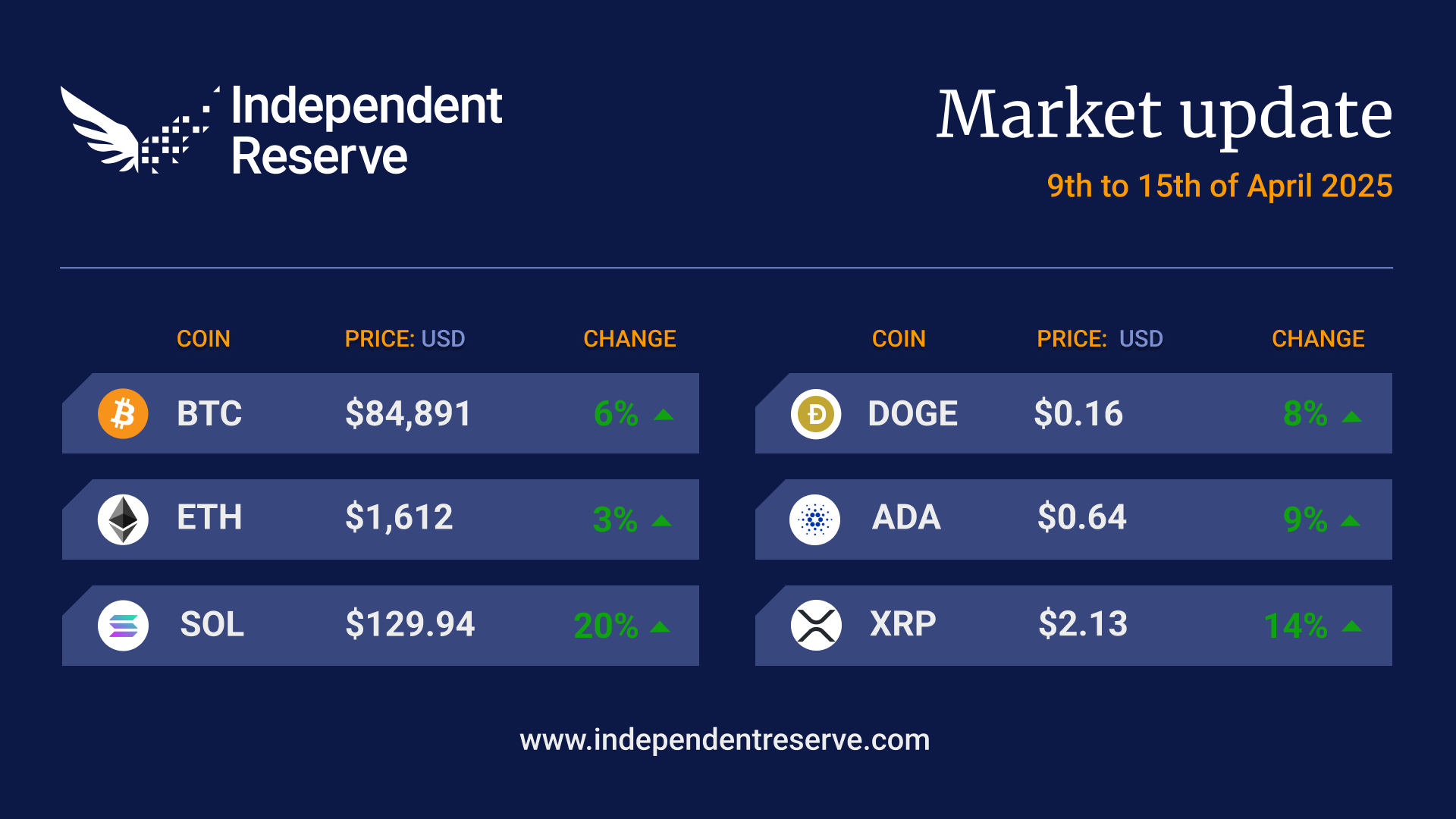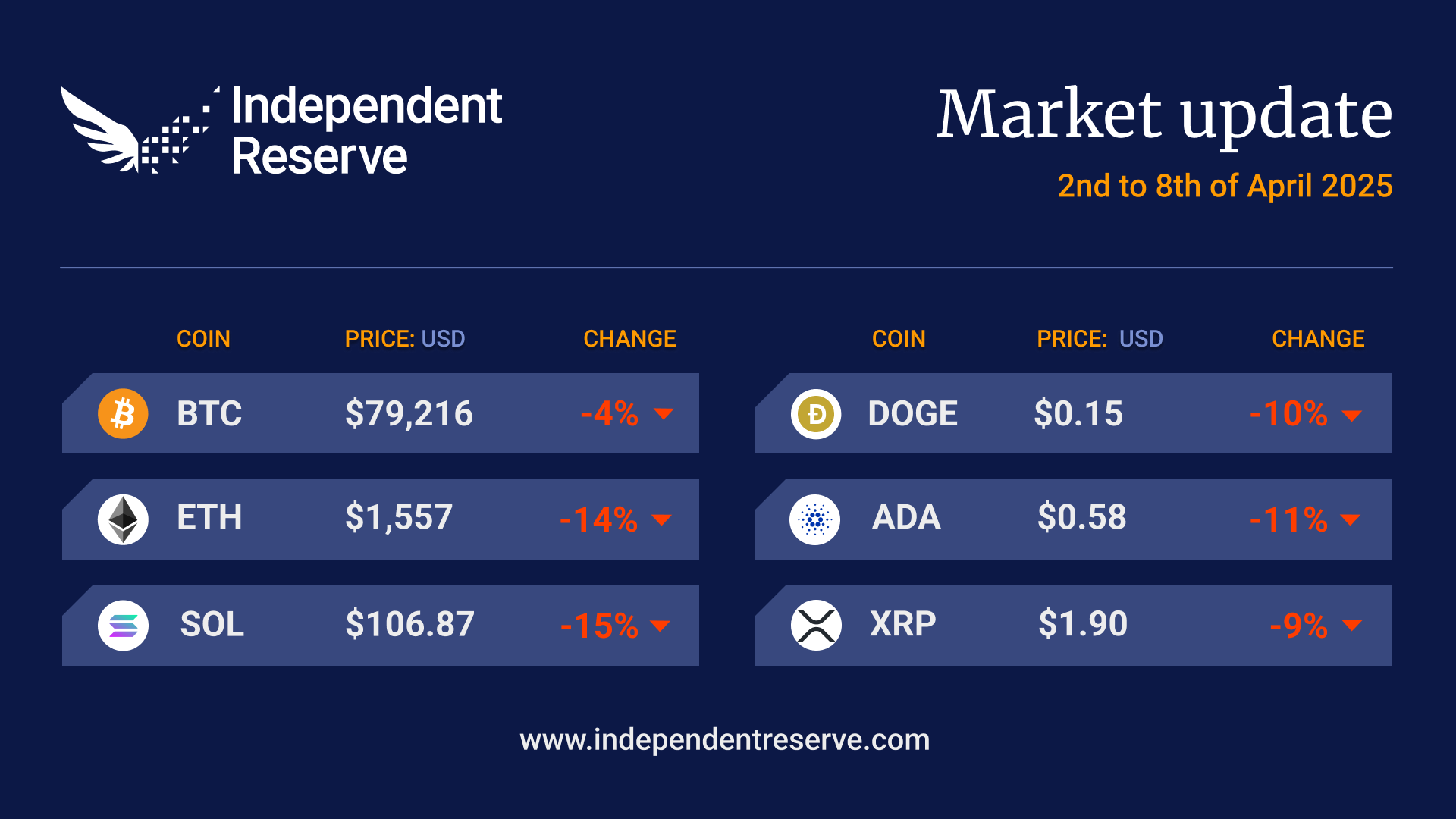In Markets
The bull market appears to have been temporarily suspended due to the prospect of large amounts of Bitcoin flowing on to the markets from Mt Gox, and the German government. Bitcoin finished the week down 11% at A$83,793 (US$56,242), while Ethereum was hit even harder and pulled back 14% to A$4,471 (US$2,999). Everything else was in the red including Solana (-8%), XRP (-12%), Dogecoin (-11.6%), Cardano (-10%) and Shiba Inu (-3.5%). On the upside, Santiment says that the MVRV scores for Dogecoin, Uniswap, Ethereum, Link, XRP and Cardano indicate a potential buy the dip opportunity. Wall Street traders are also pricing in a 72% chance the Federal Reserve will cut interest rates in September which should make macro conditions more favourable. The Crypto Fear and Greed Index is at the lowest point since January 2023 at 28, or Fear.

From the IR OTC Desk
At the current point in time, cryptocurrencies are trading independently of other high beta risk assets. This breakdown tends to indicate pricing movements caused by flow, rather than fundamental or macroeconomic drivers. Uncertainty in world politics, particularly the November 5th US election, doesn’t appear to be a critical driver of adverse credit conditions or a crisis in confidence (for the time being). For now, BTC seems to be forward profiling sell side flow.
There may also be some element of a ‘substitution effect’, where capital is being reallocated from cryptocurrencies into the strong performing US equity AI sector. If history has taught us anything, these flow-based deviations naturally correct over time. For now, though, technical levels will prove critical.
Last week we highlighted the broader range in BTC as being USD 60-70k and for ETH, USD 3,300-3,800. Pricing levels have now moved below these ranges, although there does appear to be some pricing consolidation over the last three trading sessions. During this period of uncertainty, cryptocurrencies will be more sensitive to both direct and indirect pricing influences. The best (technical) case scenario being a quick retracement into the historic ranges outlined above.
In the economic calendar this week, Thursday’s US Inflation data will prove to be the most critical. The short-term US interest rate futures market now has a circa 75% likelihood of a September rate cut (25bps reduction) and is considering the December meeting to also be finely balanced for an additional 25bp reduction. Last week’s shockingly weak US ISM Services PMI being a material catalyst for the increase in rate cut probability for the September and December FOMC meetings.
Economic releases this week include:
In Australia (AEST)
- Thursday 11:00am AU Consumer Inflation Expectations (July)
In NZ (AEST)
- Wednesday 12:00pm RBNZ Interest Rate Decision
In the US (AEST)
- Wednesday 01:00am FOMC Fed Chair Powell Testimony
- Thursday 12:00am FOMC Fed Chair Powell Speech
- Thursday 10:30pm US Inflation Data (June)
- Friday 10:30pm US PPI (June)
In China (AEST)
- Wednesday 11:30am CN Inflation Rate (June)
- Friday 1:00pm CN Balance of Trade (June)
In Singapore (AEST)
- Friday 10:00am SG GDP (Q2)
On the OTC desk, there has been negligible forced selling (if any) caused by the sharp downturn in pricing. And on a correlated basis, ETH/BTC continues to maintain a very tight range (0.0520/0.0540). Maintenance of the ETH/BTC ratio has been one of the most surprising dynamics of the week. While the news flow has been quite specific to BTC, cross asset selling has been evident. In general, cross token hedging continues to provide increased liquidity for cryptocurrencies – this is the case when the market is moving up, as well as down.
For several weeks now, OTC alt flow has been relatively quiet. The broader theme however has been growing volumes, and significantly larger transaction volumes for stable coins. This theme remains unchanged on the week; and provides a strong indication that stable coin flows are somewhat ‘majors pricing’ agnostic. Expect the US inflation data to drive risk assets on the week.
For any further information, please feel free to reach out.
In Headlines
Mt Gox ripple effects last a decade
Defunct crypto exchange Mt Gox finally began making repayments to creditors a decade after the world’s then-top exchange was hacked of 740,000 Bitcoin back in 2014. Traders panicked at the news, with the Bitcoin price plunging under A$80K (US$54K) after Mt Gox moved 47,228 BTC on-chain to repay creditors. The uncertainty will continue for a while as some Mt Gox creditors may not receive funds for two to three months, so the final tally of how much Bitcoin will get dumped won’t be known for a while. But to put things in perspective, Bitcoin’s daily exchange trading volume is larger than the entire amount to be repaid. Fundstrat founder Tom Lee is just happy to finally get the Mt Gox sales out of the way. “[Mt. Gox] was a huge overhang for many years [but knowing] that is going to disappear in July, I think it’s a reason to expect a pretty sharp rebound in the second half,” he said. While Bitcoin plunged to the lowest level since February this week, it’s worth noting that the all-time high of US$73,750 (A$109.3K) came just one month after that in March, which means anything can happen.
Don’t mention the war
The other big reason Bitcoin is tanking is thanks to the German government, which has apparently asked the office intern to sell off billions in Bitcoin for the worst possible price. Since mid-June it has flogged off around 13,000 Bitcoin of the 50K BTC it seized from a movie piracy site in January. Overnight Arkham Intelligence reported it had just sent another 16,038 BTC to exchanges and market markets. Traders are also nervous about the US Government’s stack of 213,297 Bitcoin. It appears to have sold around US$240M (A$356M) worth on Coinbase on June 26, and a transfer of another 237 Bitcoin on July 4 stretched nerves even further.
Ethereum and altcoins
The price of Ethereum and many altcoins were harder hit than Bitcoin, which doesn’t make a huge amount of sense given Mt Gox and the German government are dumping Bitcoin (and Bitcoin Cash) rather than other cryptocurrencies. As Tom Dunleavy, the managing partner of MV Capital, pointed out: “ETH in particular is going down strictly bc of 1) correlation to BTC and 2) liquidations. There is no ETH mentioned in the above assets.” That said, there is some ETH specific selling pressure coming from the Golem project, which raised 820,000 ETH back in its 2016 ICO. It sold off around US$72M (A$107M) worth in the past few days and has another US$656M (A$973M) left in its treasury to dump.
Buying the dip
If this is your first cycle, you may be concerned the bull market is over. While that’s always a possibility, history suggests that big pullbacks are par for the course for a standard Bitcoin bull run. In the bull market of 2021 Bitcoin pulled back more than 20% on six occasions, while in 2017 it pulled back closer to 40% on eight occasions. Mentions of the phrase “buy the dip” doubled on social platforms this week, and while some investors ran for the exits on Friday, the US Bitcoin ETFs actually saw inflows of US$143.1million (A$212M), bringing the week’s total to US$238.4 million (A$353M). And amid all the drama, Grayscale’s Ethereum Trust finally started trading at a premium to the underlying ETH each share represents, after three years at a discount. The closing of the discount is likely related to investors buying up the discounted shares ahead of the expected launch of Ethereum ETFs this month. ETHE currently holds US$9.5B (A$14B) in assets.
But it might be all over according to 8 of 13 indicators
Capriole Investments founder Charles Edwards cast an eye over 13 cycle top indicators in his July 2 newsletter and determined that 8 were bearish and 5 were neutral. That means it’s possible we’ve already seen this cycle’s high water mark and it’s all downhill from here. But even Edwards isn’t convinced and says that he finds the data “hard to believe” given it’s just two months after the halving and that “technicals are still bullishly skewed.”
SAB 121 heads back for another vote
The SAB 121 resolution received bipartisan support in both houses in the US to overturn the SEC’s guidance, which essentially prevents banks from custodying crypto. President Joe Biden famously vetoed the resolution in May, but it’s likely to go to another vote this week. A two thirds majority is required to overturn the veto so it’s a massive ask, but Alexander Grieve, advisor to Paradigm, believes that while it’s a “steep hill to climb [it’s] not impossible given how bipartisan the FIT vote was.”
Hong Kong reevaluates crypto regulations amid Concerns
Hong Kong is reassessing its crypto regulations due to concerns that the current framework may deter exchanges. In a recent parliamentary session, Christopher Hui, Secretary for Financial Services and the Treasury, announced that the Hong Kong Monetary Authority (HKMA) and the Securities and Futures Commission (SFC) are reviewing digital asset regulations. Hui stated that the HKMA and SFC will monitor market developments and adjust requirements for virtual asset-related activities as needed.
Independent Reserve Crypto and Bitcoin podcast
For those that enjoy long-format content about the wider cryptocurrency market, we’ve been hosting a monthly podcast series that dives into the complex nuances of crypto law, tax and entrepreneurship. Available on Spotify and YouTube, the Independent Reserve Crypto and Bitcoin podcast has just launched its 9th episode featuring Machael Bacina from Blockchain Australia and Piper Alderman.
In this episode, we discuss;
- 🔗Blockchain law enforcement
- 🧠 Smart contracts in business
- 🔐 KYC in banking
Make sure to subscribe to your favourite platform so you never miss an episode!
Until next week Happy Trading!


